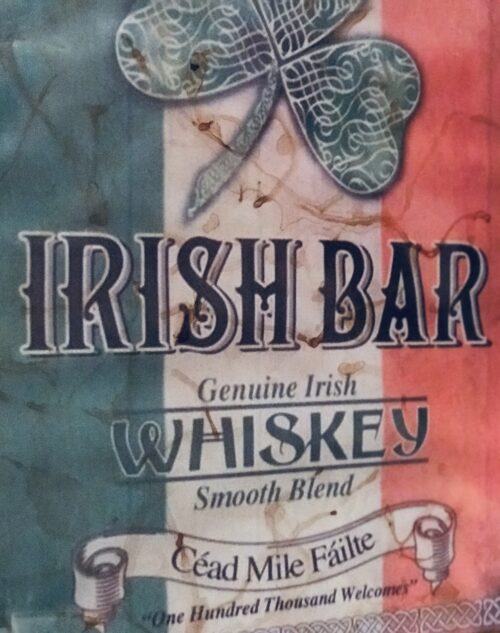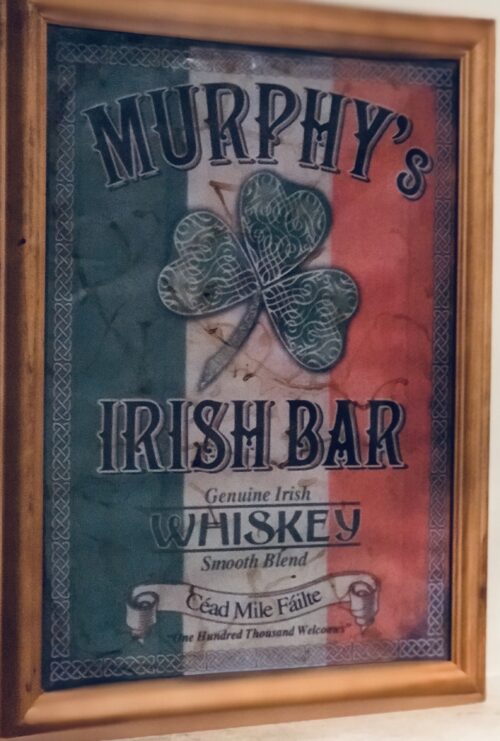-

 Beautiful depiction of Blarney Co Cork. These beautiful quaint scenes from six individual towns were originally table and have been superbly mounted and framed to create a memorable souvenir collection.Originally painted by talented local artist Roisin O Shea,the prints depict everyday scenes of streetlife in Killarney,Kilkenny,Blarney,Galway,Kinsale and Youghal. Lahinch Co Clare 33cm x 39cm
Beautiful depiction of Blarney Co Cork. These beautiful quaint scenes from six individual towns were originally table and have been superbly mounted and framed to create a memorable souvenir collection.Originally painted by talented local artist Roisin O Shea,the prints depict everyday scenes of streetlife in Killarney,Kilkenny,Blarney,Galway,Kinsale and Youghal. Lahinch Co Clare 33cm x 39cm -

 Beautiful depiction of Youghal Co Cork. These beautiful quaint scenes from six individual towns were originally table and have been superbly mounted and framed to create a memorable souvenir collection.Originally painted by talented local artist Roisin O Shea,the prints depict everyday scenes of streetlife in Killarney,Kilkenny,Blarney,Galway,Kinsale and Youghal. Lahinch Co Clare 33cm x 39cm
Beautiful depiction of Youghal Co Cork. These beautiful quaint scenes from six individual towns were originally table and have been superbly mounted and framed to create a memorable souvenir collection.Originally painted by talented local artist Roisin O Shea,the prints depict everyday scenes of streetlife in Killarney,Kilkenny,Blarney,Galway,Kinsale and Youghal. Lahinch Co Clare 33cm x 39cm -

 Beautiful depiction of Kilkenny City. These beautiful quaint scenes from six individual towns were originally table and have been superbly mounted and framed to create a memorable souvenir collection.Originally painted by talented local artist Roisin O Shea,the prints depict everyday scenes of streetlife in Killarney,Kilkenny,Blarney,Galway,Kinsale and Youghal. Lahinch Co Clare 33cm x 39cm
Beautiful depiction of Kilkenny City. These beautiful quaint scenes from six individual towns were originally table and have been superbly mounted and framed to create a memorable souvenir collection.Originally painted by talented local artist Roisin O Shea,the prints depict everyday scenes of streetlife in Killarney,Kilkenny,Blarney,Galway,Kinsale and Youghal. Lahinch Co Clare 33cm x 39cm -

 Beautiful depiction of Kinsale Co Cork These beautiful quaint scenes from six individual towns were originally table and have been superbly mounted and framed to create a memorable souvenir collection.Originally painted by talented local artist Roisin O Shea,the prints depict everyday scenes of streetlife in Killarney,Kilkenny,Blarney,Galway,Kinsale and Youghal. Lahinch Co Clare 33cm x 39cm
Beautiful depiction of Kinsale Co Cork These beautiful quaint scenes from six individual towns were originally table and have been superbly mounted and framed to create a memorable souvenir collection.Originally painted by talented local artist Roisin O Shea,the prints depict everyday scenes of streetlife in Killarney,Kilkenny,Blarney,Galway,Kinsale and Youghal. Lahinch Co Clare 33cm x 39cm -

 Large,colourful,beautifully illustrated and wonderfully eclectic poster depicting some of the best and most iconic Dublin watering holes.This superb poster depicts a variety of the facades,architectural features and idiosyncrasies of many of the best and most celebrated traditional Dublin public houses.Favourite watering holes featured here include; The Stags Head of Dame Court,O'Connells of South Richmond St ,Ryans of Parkgate St, Doheny & Nesbitts of Baggott St ,Ryans of Haddington Road,Slatterys of Rathmines, The Palace Bar of Fleet St,McDaids off Grafton St,Kehoe' s of South Anne St,The International Bar, The Brazen Head,Mulligans of Poolbeg St and Madigans of North Earl St to name but a few. Its fair to say another 50 of these posters could have been commissioned and you still wouldn't run out of timeless classic Dublin watering holes. 57cm x 84 cm
Large,colourful,beautifully illustrated and wonderfully eclectic poster depicting some of the best and most iconic Dublin watering holes.This superb poster depicts a variety of the facades,architectural features and idiosyncrasies of many of the best and most celebrated traditional Dublin public houses.Favourite watering holes featured here include; The Stags Head of Dame Court,O'Connells of South Richmond St ,Ryans of Parkgate St, Doheny & Nesbitts of Baggott St ,Ryans of Haddington Road,Slatterys of Rathmines, The Palace Bar of Fleet St,McDaids off Grafton St,Kehoe' s of South Anne St,The International Bar, The Brazen Head,Mulligans of Poolbeg St and Madigans of North Earl St to name but a few. Its fair to say another 50 of these posters could have been commissioned and you still wouldn't run out of timeless classic Dublin watering holes. 57cm x 84 cm -

 Beautiful and poignant collection of four of the 1916 Easter Rising Rebel Leaders who were executed by the British Crown Forces at Kilmainham Jail a few weeks later.Featured here are Padraig Pearse,Thomas Clarke,James Connolly,Thomas Kent Thomas Kent (Irish: Tomás Ceannt; 29 August 1865 – 9 May 1916) was an Irish nationalist who was court-martialled and executed following a gunfight with the Royal Irish Constabulary (RIC) on 9 May 1916, in the immediate aftermath of the Easter Rising.
Beautiful and poignant collection of four of the 1916 Easter Rising Rebel Leaders who were executed by the British Crown Forces at Kilmainham Jail a few weeks later.Featured here are Padraig Pearse,Thomas Clarke,James Connolly,Thomas Kent Thomas Kent (Irish: Tomás Ceannt; 29 August 1865 – 9 May 1916) was an Irish nationalist who was court-martialled and executed following a gunfight with the Royal Irish Constabulary (RIC) on 9 May 1916, in the immediate aftermath of the Easter Rising.Easter Rising
Kent was part of a prominent nationalist family who lived at Bawnard House, Castlelyons, County Cork. They were prepared to take part in the Easter Rising, but when the mobilisation order was countermanded, they stayed at home. The rising nevertheless went ahead in Dublin, and the RIC was sent to arrest well-known sympathizers throughout the country, including known members of the Irish Republican Brotherhood, Sinn Féin, and the Irish Volunteers. When the Kent residence was raided they were met with resistance from Thomas and his brothers Richard, David and William. A gunfight lasted for four hours, in which an RIC officer, Head Constable William Rowe, was killed and David Kent was seriously wounded. Eventually the Kents were forced to surrender, although Richard made a last minute dash for freedom and was fatally wounded.Trial and execution
Thomas and William Kent were tried by court martial on the charge of armed rebellion. William was acquitted, but Thomas was sentenced to death. David Kent was brought to Dublin where he was charged with the same offence, found guilty and sentenced to death, but the sentence was commuted and he was sentenced to five years penal servitude. Thomas Kent was executed by firing squad in Cork on 9 May 1916, the only person outside of Dublin to be shot for his role in the events surrounding Easter Week (Roger Casement was hanged for treason in London). Kent was buried in the grounds of Cork Prison, formerly the Military Detention Barracks at the rear Collins Barracks, Cork (formerly Victoria Barracks). The former army married quarters to the rear of Collins Barracks are named in his honour.State funeral
Taoiseach Enda Kenny offered a state funeral to the Kent family early in 2015, which they accepted. Kent's remains were exhumed from Cork prison in June 2015 after being buried for 99 years. The analysis of Kent's remains, which had been found in a shallow, quicklime-filled grave, involved the State Pathologist's Office, the National Forensic Coordination Office at the Garda Technical Bureau, Forensic Science Ireland, and scientists from University College Dublin, and the scientific team was led by Dr. Jens Carlsson from the University of California-Davis. The State funeral was held on 18 September 2015 at St Nicholas' Church in Castlelyons. Kent lay in state at Collins Barracks in Cork the day before. The requiem mass was attended by President Michael D. Higgins, with Enda Kenny delivering the graveside oration.Memorials
The main railway station in Cork, Kent Station was named after Thomas Kent in 1966. The bridge over the River Blackwater in Fermoy, Co. Cork, where Thomas Kent was detained following his arrest, was named after him and his brothers in 2016. Bust of Kent at Cork Kent railway station by sculptor James MacCarthy.
Bust of Kent at Cork Kent railway station by sculptor James MacCarthy. -

 Superb vintage WW1 recruitment poster imploring the young men of Ireland to join the British Army.The poster depicts a lone piper with the famous mascot of the Royal Irish Regiment ,an Irish Wolfhound. 47cm x 38cm Nenagh Co TipperaryThe British Army was a volunteer force when war broke out in 1914, and within weeks thousands of Irishmen had signed up to serve 'King and Country'. Ireland had a strong military tradition in the British armed forces, dating back to at least the early 1500s, and when war was declared on August 4, 1914, there were some 20,000 Irishmen already serving from a total army strength of some 247,000. In addition, there were another 30,000 in the first-line reserve, from a total of 145,000. But more were quickly needed. Secretary for War Lord Kitchener told the British cabinet that it would be a three-year conflict requiring at least one million men, meaning a recruitment drive was immediately undertaken. Posters quickly appeared across the country, focused on attracting men from all background Some appealed to a sense of duty and honour, but appeared to be aimed at British-born nationals rather than Irishmen.
Superb vintage WW1 recruitment poster imploring the young men of Ireland to join the British Army.The poster depicts a lone piper with the famous mascot of the Royal Irish Regiment ,an Irish Wolfhound. 47cm x 38cm Nenagh Co TipperaryThe British Army was a volunteer force when war broke out in 1914, and within weeks thousands of Irishmen had signed up to serve 'King and Country'. Ireland had a strong military tradition in the British armed forces, dating back to at least the early 1500s, and when war was declared on August 4, 1914, there were some 20,000 Irishmen already serving from a total army strength of some 247,000. In addition, there were another 30,000 in the first-line reserve, from a total of 145,000. But more were quickly needed. Secretary for War Lord Kitchener told the British cabinet that it would be a three-year conflict requiring at least one million men, meaning a recruitment drive was immediately undertaken. Posters quickly appeared across the country, focused on attracting men from all background Some appealed to a sense of duty and honour, but appeared to be aimed at British-born nationals rather than Irishmen.










